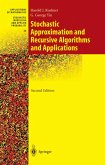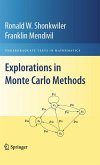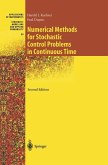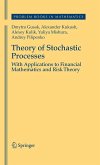This book presents a thorough development of the modern theory of stochastic approximation or recursive stochastic algorithms for both constrained and unconstrained problems. This second edition is a thorough revision, although the main features and structure remain unchanged. It contains many additional applications and results as well as more detailed discussion.
The basic stochastic approximation algorithms introduced by Robbins and MonroandbyKieferandWolfowitzintheearly1950shavebeenthesubject of an enormous literature, both theoretical and applied. This is due to the large number of applications and the interesting theoretical issues in the analysis of "dynamically de?ned" stochastic processes. The basic paradigm is a stochastic di?erence equation such as ? = ? + Y , where ? takes n+1 n n n n its values in some Euclidean space, Y is a random variable, and the "step n size" > 0 is small and might go to zero as n??. In its simplest form, n ? is a parameter of a system, and the random vector Y is a function of n "noise-corrupted" observations taken on the system when the parameter is set to ? . One recursively adjusts the parameter so that some goal is met n asymptotically. Thisbookisconcernedwiththequalitativeandasymptotic properties of such recursive algorithms in the diverse forms in which they arise in applications. There are analogouscontinuous time algorithms, but the conditions and proofs are generally very close to those for the discrete time case. The original work was motivated by the problem of ?nding a root of a continuous function g ¯(?), where the function is not known but the - perimenter is able to take "noisy" measurements at any desired value of ?. Recursive methods for root ?nding are common in classical numerical analysis, and it is reasonable to expect that appropriate stochastic analogs would also perform well.
The basic stochastic approximation algorithms introduced by Robbins and MonroandbyKieferandWolfowitzintheearly1950shavebeenthesubject of an enormous literature, both theoretical and applied. This is due to the large number of applications and the interesting theoretical issues in the analysis of "dynamically de?ned" stochastic processes. The basic paradigm is a stochastic di?erence equation such as ? = ? + Y , where ? takes n+1 n n n n its values in some Euclidean space, Y is a random variable, and the "step n size" > 0 is small and might go to zero as n??. In its simplest form, n ? is a parameter of a system, and the random vector Y is a function of n "noise-corrupted" observations taken on the system when the parameter is set to ? . One recursively adjusts the parameter so that some goal is met n asymptotically. Thisbookisconcernedwiththequalitativeandasymptotic properties of such recursive algorithms in the diverse forms in which they arise in applications. There are analogouscontinuous time algorithms, but the conditions and proofs are generally very close to those for the discrete time case. The original work was motivated by the problem of ?nding a root of a continuous function g ¯(?), where the function is not known but the - perimenter is able to take "noisy" measurements at any desired value of ?. Recursive methods for root ?nding are common in classical numerical analysis, and it is reasonable to expect that appropriate stochastic analogs would also perform well.
From the reviews of the second edition: "This is the second edition of an excellent book on stochastic approximation, recursive algorithms and applications ... . Although the structure of the book has not been changed, the authors have thoroughly revised it and added additional material ... ." (Evelyn Buckwar, Zentralblatt MATH, Vol. 1026, 2004) "The book attempts to convince that ... algorithms naturally arise in many application areas ... . I do not hesitate to conclude that this book is exceptionally well written. The literature citation is extensive, and pertinent to the topics at hand, throughout. This book could be well suited to those at the level of the graduate researcher and upwards." (A. C. Brooms, Journal of the Royal Statistical Society Series A: Statistics in Society, Vol. 169 (3), 2006)








